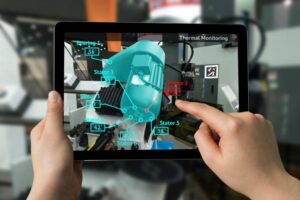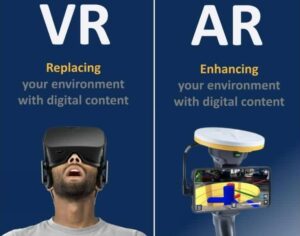What is Augmented Reality and Virtual Reality (AR/VR)?
In recent days, almost everyone spends time looking at screens. We have all literally made smartphones, computers, and televisions to become a big part of our lives. Thanks to these mediums, we can get news, use social media, watch movies, and explore the internet. Meanwhile, recent inventions have brought about Augmented Reality (AR) & Virtual Reality (VR), two technologies that are changing the way we use screens.
These inventions have created new and exciting interactive experiences. While virtual reality makes you explore a computer-generated world through a headset, augmented reality adopts a little different path. In other words, rather than transport you to a virtual world, augmented reality takes digital images and layers them on the real world around you, using either a clear visor or smartphone.
Virtual reality allows you to explore an underwater environment. On the other hand, thanks to augmented reality, you’ll be exposed to the world of fish swimming through the world around you. In this article, we’ll be revealing crucial points about AR & VR, their history, and also reveal a brief comparison between both.
History of AR & VR
Primitive virtual reality systems began in the 1950s & 1960s; however, the concepts of VR & AR have not yet become popular in military applications until the early 1980s. Motion pictures such as Tron, Minority Report, and The Matrix all provided futuristic riffs on how these technologies will evolve in the future.
The Sega VR in 1993 was the earliest mainstream attempt at launching a VR headset, and was an add-on to the Sega Genesis gaming system. Although it never really got to the market, it was still appealing to consumers in the technology world.
However, it was during the Oculus Rift in 2010 that a VR headset became successful with a consumer audience. The downside is that even till the present times; these devices haven’t dropped significantly in price, and have remained largely of interest to niche, gaming-focused users.
Moving forward, augmented reality was separated from virtual reality during the 199s, and was revealed to the public in 1998, when TV broadcasters started overlaying a yellow line on the football field as a better indication of the distance to a first down.
A decade later, different apps around AR technology were created for both military use (for e.g. in fighter jet cockpits) and consumer use, as print magazines and packaged goods started embedding QR codes that can be scanned using a consumer’s cell phone, which makes the product become active with a short 3D video.
It wasn’t until 2014 that Google rolled out Google Glass, partly to equip everyone with a head-mounted display AR device. The augmented reality headset that was controlled through voice and touch gestures suffered skepticism and critics. This criticism was mostly borne out of the new reality that people were recording video 24/7 in the open space.
Therefore, privacy quickly attracted a lot of major talking points in consumer AR. Google ultimately suspended the project and a few years later, the launching was repeated, with enterprise users in mind. Without further ado, let’s quickly highlight the crucial points about AR & VR.

What Is Augmented Reality [AR] and Types?
To put quite simply, virtual reality was designed to replace your vision while augmented reality was made to complement or add to it. AR tools like the Microsoft HoloLens, the original Google Glass, and some other enterprise-level “smart glasses” are transparent, and allow you to see everything before you like when you are wearing clear glasses.
The AR technology is created to enhance effortless movement and at the same time project images over whatever your eyes capture. Smartphones are not excluded from this concept, as it features AR apps and games like Pokemon Go that uses your phone’s camera to track your environment and visually overlay extra information alongside it.
Also, AR displays are capable of offering something as easy as a text overlay, showing the time, to something as complicated as holograms of furniture hanging in the middle of a room. Pokemon Go mirrors a Pokemon on your screen resting on top of anything the camera is facing.
Meanwhile, the HoloLens and other smart glasses, allows you to virtually place floating app windows and 3D decorations around you. However, these images are often expensive, and we’re still anticipating an AR headset both realistically priced and with sufficient features for it to be seen as a genuine consumer product.
For this reason, most of the AR experiences available to many people are through smartphones (using your phone’s camera and screen to augment your reality in a very limited view. Don’t forget AR promises almost limitless possibilities.
Phone-inclined AR software has increasingly recognized environments and provides extra details of what it sees for recent years, as well as offers live translation of text or pop-up reviews of restaurants as you visualize them.
Dedicated AR headsets like the HoloLens, can even exceed this performance by allowing you to virtually place various apps as floating windows around you. These devices effectively offer you a modular, multi-monitor, computing setup. However, purely AR headsets are considered very expensive and too large to be seen as daily computing devices.
Types of Augmented Reality [AR]
Microsoft has provided us with two types of augmented reality (AR) namely Maker-based AR and Marker-less AR.
- Marker-based Augmented Reality
The marker-based AR is facilitated by physical images or markers that are captured using smartphone cameras to place the digital parts on top of it. Meanwhile, these markers can replace an object or visual part such as a logo, or a QR code.
- Marker-less Augmented Reality
Unlike the marker-based AR, the marker-less AR is more complex and complicated and doesn’t depend on markers and rather lets users choose where to showcase the content. The devices use a recognition algorithm in exploring patterns, colors, and the same features to detect what an object is.
After this detection, the devices will depend on GPS, accelerometers, cameras, and compasses to superimpose a photo within the real-world environment.

What Is Virtual Reality [VR] and Types ?
Virtual Reality (VR) is different from augmented reality because it is an immersive experience, isolating users from the real world, especially requiring the aid of headset and headphones. Every five senses it has can be combined. However, it does not incorporate things into the real world, but rather replaces the real world and places users in entirely new worlds.
VR lets its users use computer automation for a three-dimensional experience. This technology incorporates hardware such as headsets, controllers and treadmills and software such as game engines, content management and training simulators to provide the complete experience.
Virtual reality is made up of two major features. The first is immersion (it operates by deleting the real world and completely placing users in the virtual world). And then there’s the interaction (it increases the immersion experience by letting users control elements. There are many fields that have combined VR such as retail, which lets users try on clothes, accessories or even a new haircut.
By 2028, this industry is predicting VR to grow by approximately $18 billion. Meanwhile, the automotive industry also operates VR including companies such as Mercedes-Benz, Audi, and Tesla, which all use the technology to create virtual showrooms. By 2026, the global automotive VR industry is expected to grow to $54 billion.
Types of Virtual Reality [VR]
Three major types of Virtual Reality (VR) includes the following;
- Non-immersive Virtual Reality
It is called non-immersive VR because it is characterized by computer-generated virtual surroundings that allow users to simultaneously understand and control their physical reality. It is one of the most popular types and depends on a video game console or computer to create an environment. It is also built to enable users to make an impact in a computer-generated world which allows them to take charge of activities in the absence of direct interaction. A major instance of this type of VR is video games that allow users to control a character without interacting directly.
- Semi-immersive Virtual Reality
The major reason it is called semi-immersive VR is its provision of experience that is partially based in a virtual environment. This type of VR enables users to make a virtual tour without direct interaction with the physical surroundings. Thanks to VR glasses, users can enjoy a virtual environment even without physical connection.
In other words, as a user, you can find yourself in a virtual environment without any physical sensation. This type of VR relies on strong and high-resolution sensors to display realism. Some common instances include educational and training tools such as flight simulators that pilots use in training, as it operates large projector systems and graphical computing.
- Fully-immersive Virtual Reality
Fully-immersive VR is the most realistic simulation experience, thanks to its ability to combine sound, sight and in some occasions, olfactory sensations. This technology stimulates as much sense as possible to provide a true-to-life experience. It is entirely confined away from the physical environment.
Thanks to fully-immersive VR, you can be a user that physically presents in the virtual world and experience first-hand kinds of events. To achieve it, you need tools like body detectors, VR headsets, gloves, smelling detectors and sense detectors. A good example of where this technology is utilized is in the virtual gaming zone, involving players that interact with the virtual environment to compete against each other.
Key Differences between AR & VR

Both augmented reality and virtual reality have to do with simulated reality. However, they depend on different underlying parts and generally serve different audiences. For instance, in VR, a user almost always wears an eye-covering headset and headphones to fully replace the physical world with the virtual one.
This activity is primarily to get rid of the physical environment as much as possible and insulate the user from it. Immediately you are inside, the VR universe can be coded to offer just about anything, including a lightsaber battle with Darth Vader to a realistic (yet completely invented) recreation of earth.
Additionally, while virtual reality features several business applications in product design, training, architecture and retail; in recent times, most of the VR applications are created around entertainment, like gaming. On the other hand, augmented reality mainly integrates the simulated environment with the physical one.
In most applications, you can be a user who depends on a smartphone or tablet screen to achieve it, by pointing the phone’s camera at an area of interest. You can also accomplish this action by creating a live-streaming video of that scene on the screen.
The screen can then be overlaid with essential information including implementations like navigation information repair instructions, or diagnostic data. Nonetheless, you can use AR in entertainment applications. A perfect example is the mobile game Pokemon Go, where players try to catch virtual creatures while moving around the physical world.
Again, both AR and VR are reality technologies that either improve or replace a real-life surrounding using a simulated one. However, AR augments your environment via the addition of digital elements to a live view, often via the use of the camera on a smartphone.
On the other hand, VR offers a fully immersive experience by replacing a real-life surrounding with a simulated one. In other words, Augmented Reality augments your environment through the addition of digital elements to a live view, usually with the camera on the smartphone.
In augmented reality, a virtual surrounding is created to co-exist with the physical world, aiming to be informative and offer extra data about the real world. With this data, a user can access it without doing any research. For instance, industrial AR apps are capable of offering immediate troubleshooting information when a handset is positioned at a piece of falling tools.
Conclusion
Augmented Reality and Virtual Reality are amazing interfaces and engaging new applications. They are both growing at a pretty rapid pace that got most experts to predict their continuous growth in popularity in the near future. However, there are several challenges a business must solve before they can successfully apply this new technology.
These challenges can be solved by learning about every component, beginning with a business need, and partnering with business sectors. This proactiveness will enable IT professionals to make the right choices concerning this emerging trend.
